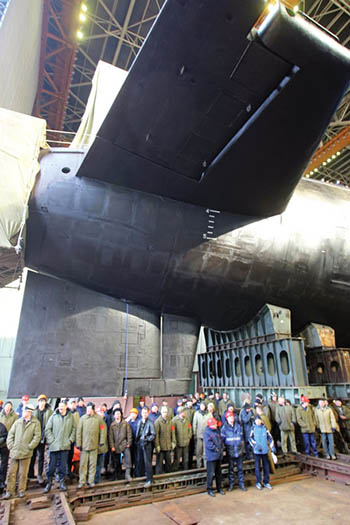
Alamy
Most of the shipyards that built the Soviet fleet that challenged the U.S. Navy now are not in Russia, working at less than capacity, or building commercial ships, tugs, and offshore drilling platforms instead of warships. Furthermore, today’s Russian shipyards use outdated machinery and methods, largely because of an industry depression for two decades after the fall of the Soviet Union.
Submarines and small combatants are the most viable navy products of the country’s shipbuilding industry. When the Cold War ended in 1991, there were four yards building nuclear-powered submarines: Krasnoye Sormovo (in Gor’kiy or Nizhny Novgorod), Admiralty* (in St. Petersburg), Komsomol’sk (on the Amur River in the Far East), and Sevmash (in Severodvinsk on the White Sea).
In 1992 the decision was made to concentrate all nuclear submarine construction at the huge Sevmash yard. Located in the Arctic, Sevmash (a Russian acronym for Northern Machinebuilding Enterprise) has three large construction halls with a reported 17 building positions that provide more submarine-building capacity than both U.S. submarine yards combined. At the end of the Cold War, Sevmash had more than 40,000 employees and today employs about 25,000 people.
Currently diesel submarines are being built only at Admiralty and Sevmash, although the Krasnoye Sormovo and Komsomol’sk yards could undertake their construction. Submarine construction—nuclear and conventional, strategic and multi-purpose—has a high priority in Russian defense investment.
All submarine yards remained in the “new” Russia after the Soviet Union imploded, but only half of the surface ship yards remained. The yards that were divested from Russia as a result of the Soviet breakup were located in the newly independent Baltic States and Ukraine. The most critical loss was the sprawling Black Sea Shipyard at Nikolayev in the Ukraine. That yard had produced all Soviet aviation ships beginning with the helicopter carrier-missile cruiser Moskva, completed in 1967.
Russian officials have indicated that future aircraft carriers will be built at the Sevmash yard, although several other Russian yards have constructed large surface warships, including the nuclear-powered Kirov-class battle cruisers and super tankers. Today the lone Russian aviation ship—the carrier Admiral Kuznetsov—is undergoing a lengthy overhaul and modernization at Sevmash.
The original building hall at Sevmash was erected in the 1930s to build two battleships simultaneously, side-by-side; however, constructing a modern aircraft carrier at the Sevmash yard will be easier said than done. The yard does not have the crane capacity and other facilities to assemble large blocks or sections of major ships, as is done in modern Western, Chinese, Korean, and Japanese yards. Still, one should not underestimate the ability of Russian ship designers and builders to produce a large carrier at Sevmash, albeit with difficulty.
As noted in previous articles in this series, Russian production of cruisers and destroyers is at a halt because of Ukraine’s refusal to provide gas turbines for those ships. Although Russian factories soon will be able to provide gas turbines, major modifications will be needed to those unfinished ships to accommodate those engines. Meanwhile, smaller frigates and corvettes are being produced at an impressive rate at several Russian yards—primarily Yantar in Kaliningrad, Almaz in St. Petersburg, and Zelenodol’sk on the Volga River near Kazan. While these warships are “small” by U.S. standards, they are armed with advanced antiair/antimissile systems and cruise missiles, both for the antiship and land-attack roles. Several of these ships gave an impressive demonstration of their firepower in 2016 when they fired cruise missiles from the Caspian Sea and eastern Mediterranean into targets in Syria.
The Russian leadership has announced aspirational plans to construct additional aircraft carriers. Also on the “wish list” are a new class of conventional gas-turbine-powered destroyers and a series of 12 nuclear-powered destroyers. The last—designated the “Lider” (leader) class—will have a displacement between 10,000 and 15,000 tons and will be armed with advanced weapons. “The Lider will be a universal ship, triple- hatted as a destroyer, large ASW ship and guided missile cruiser,” according to Valeriy Polovinki, advisor to the Krylov State Research Center, which developed the destroyer’s preliminary design. Specific systems that have been cited for the new warship are the Kalibr and Onyx cruise missiles and the naval version of the S-500 antiair/antimissile system.
The first ships of the Lider class will be completed “no earlier than 2023–2025,” according to the TASS news agency. Although no building yard has been publicly identified, the most probable sites are the Baltic or Severnaya (formerly Zhdanov) shipyards in St. Petersburg. The Baltic yard built the 28,000-ton Kirov-class battle cruisers, nuclear-powered icebreakers, and the 40,000-ton, nuclear-powered Ural multipurpose ship, employed for electronic intelligence collection, missile and space tracking, and communications relay. (Completed in 1989, the Ural was laid up in 2002, because of her high operating costs, and now is being scrapped.) The Zhdanov yard in the past built the 13 destroyers of the Udaloy class and 21 destroyers of the Sovremenny class (including four units for China).
Thus, Russia retains a large, multifaceted shipbuilding industry. Much of the equipment at the shipyards is outdated, however, and there are problems with component suppliers, both within Russia and in former Soviet states. Despite those problems, the infrastructure is sufficient to build a large fleet—if the Kremlin can find the rubles to pay for one. In the meantime, Sevmash likely will remain the largest and busiest shipyard in the county, with an emphasis on building submarines—the current capital ships of the Russian Navy.
*Admiralty Shipyard and the adjacent Sudomekh Shipyard were consolidated into a single administrative entity—the United Admiralty Association—in 1972.


